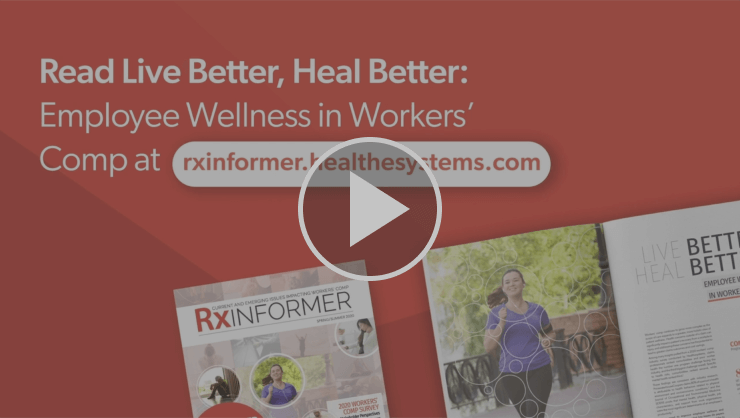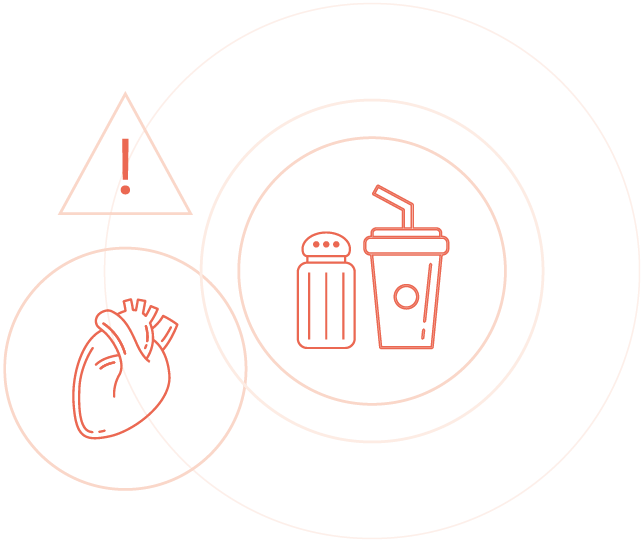Understanding employees’ overall health is a growing component of workers’ comp. Comorbidities, fatigue, mental health, and other personal health factors can not only impact the effective management of claims, but in some cases the likelihood of injury.
Among many insights pulled from a 2020 workers’ comp industry survey conducted by Healthesystems, claims professionals ranked comorbidities and poor worker health the number one program challenge facing the industry, and the third biggest challenge overall. Specific to health risks, comorbidities ranked second, while mental health ranked third.1

Program Challenge to Workers’ Comp1
Understanding employees’ overall health is a growing component of workers’ comp. Comorbidities, fatigue, mental health, and other personal health factors can not only impact the effective management of claims, but in some cases the likelihood of injury.
Among many insights pulled from a 2020 workers’ comp industry survey conducted by Healthesystems, claims professionals ranked comorbidities and poor worker health the number one program challenge facing the industry, and the third biggest challenge overall. Specific to health risks, comorbidities ranked second, while mental health ranked third.1

With a need to improve employee wellness and workplace environments, what key issues do payers and employers face, and what steps can they take to address these issues?

A comorbidity is the presence of an additional, often independent, medical condition co-occurring with a primary condition; in workers’ comp the primary condition would be the workplace injury. In workers’ comp, “comorbidity” frequently refers to a chronic health condition that may be lifelong.
Comorbid conditions are impacted by lifestyle choices, including diet, exercise, smoking, drinking, and other substance use, as well as by genetics, socioeconomic factors, and more.
Despite increases to life expectancy, healthcare spending, and improved health outcomes, chronic comorbid conditions continue to rise in the U.S.2 For example:



Workers’ comp claims with a comorbid diagnosis have tripled in the last decade, and such claims typically are associated with twice the medical costs of other claims.6

Oftentimes, workers’ comp claims must manage comorbidities in order to effectively help injured workers recover, essentially complexifying claims and increasing costs.
Diverse populations face diverse health risks. Certain age and ethnicity groups are more likely to experience particular chronic conditions:

When faced with comorbidities, patients may require medications to manage these conditions. However, when coupled with a workplace injury, there is the potential for various drug-drug and drug-disease interactions. Furthermore, the side effects of various comorbid and workplace injury medications may require treatment, and if not managed properly, could lead to polypharmacy, the problematic use of several concurrent medications.





Wellness programs are comprehensive health initiatives designed to maintain or improve wellbeing by encouraging proper diet, exercise, stress management, and illness prevention. When effectively deployed, they have the potential to improve employees’ overall health, which could also decrease medical care costs down the line, and by extension, medical premiums.
Wellness programs often include wellness screenings to identify health risks and create intervention opportunities to promote healthier lifestyles. This can include the collection of biometric data and the use of health questionnaires.
Approximately half of U.S. employers offer wellness promotion initiatives, and the larger the employer, the more likely they are to have a comprehensive program.11 Wellness programs differ greatly, but often they include information resources, health management tools, campaigns, and other components to carry out health initiatives including:
Because wellness programs can improve employee health to manage comorbidities, they can help injured workers down the line. But exactly how effective are wellness programs in accomplishing this?
According to a study of 33,000 employees, worksites with a wellness program had an 8.3% higher rate of employees who reportedly engaged in regular physical exercise, and a 13.6% higher rate of employees who reported actively managing their weight.12
Wellness programs are also linked to statistically significant and clinically meaningful reductions in smoking behavior.11 However, not all wellness programs are built the same, and some can be ineffective at improving wellness.
More research is needed to determine which types of wellness programs are most effective and for what health concerns, especially considering that only half of employers have formally evaluated program impacts.11 But a key component to best utilizing wellness programs is tailoring such programs to specific work organizations.
Employers need to take an active hand in forming wellness programs so they can best serve employees, and so they can best maximize employee participation. In one study, of the employees who had access to wellness programs, only 57.8% used them.13
Effective wellness programs approach wellness with a continuous quality improvement attitude and solicit feedback from employees to improve the program.11 Key facilitators of effective wellness programs include:11
Furthermore, research found that employers who use incentives for health screening activities reported significantly higher participation rates than employers that did not offer incentives. Employers that offered incentives saw 69% of their workforce complete health risk assessments (HRA) and 57% complete clinical screenings; employers that offered no incentives saw 29% completion for HRAs and 38% completion for clinical screenings.11

Fatigue can be described as a level of tiredness, sleepiness, and reduced energy that requires increased effort to perform tasks at a desired level. If not properly managed, fatigue can increase the likelihood of injury and long-term health effects.



and hypertension can arise from fatigue, increasing long-term risks for adverse cardiac events15
illness, and lack of physical activity can be caused by fatigue17
Approximately 35% of workers cite lack of sleep as a top impediment to a healthy lifestyle,2 and depending on industry and work environments, this can be much higher.
While employers are greatly concerned with fatigue, only 20% of workers understand the risks of fatigue,18 potentially putting them at risk for workplace injuries and long-term health effects. This is made worse considering:18
While any job can be tiring, certain workers are more at risk than others. Approximately 15 million Americans work full time on evening, night, rotating, or other irregular shifts, and these work schedules can increase the odds of fatigue.17
The following workers see greater risks related to fatigue:
Whether an employee has a pre-existing condition or is taking medications for a workplace injury, it is important to note that their drug regimen could be increasing fatigue. The following drugs can increase workplace fatigue:
Because the causes and work environments that lead to workplace fatigue vary, there is no single solution for addressing fatigue, but there are multiple strategies that can be employed.
Though most workplaces provide time and spaces for brief rests, the nature of work may require more accommodations to improve the quality of rest an employee can enjoy.
Calm, quiet environments can be helpful. One study found that allowing for 30-40 minute naps during night shifts decreased fatigue burden.16 While this may not be suitable for all workplaces, other research finds that letting workers rest from repetitive tasks by switching duties can help them maintain alertness, decreasing fatigue.21
By strategically scheduling shifts to allow employees 10 hours between shifts so they can get enough sleep, employers can reduce the likelihood of fatigue.20 Staying on a shift pattern for a few weeks before rotating can allow employees to grow used to different sleep schedules, and scheduling consecutive days off allows workers to better enjoy their time off.
Though this depends significantly on work environments, investing in certain equipment or other resources can ease employees’ work burdens. For example, anti-fatigue mats, shoe inserts, and sit and stand stations have been proven to reduce fatigue for retail workers.20 Utilizing similar occupation-specific countermeasures could help reduce fatigue.
It is important to have policies and practices in place to minimize, document, and address fatigue head on. The first step is to create awareness of the risks of fatigue in the workplace, especially as employees are less likely to think of fatigue as a safety issue when compared to employers.21
Simple five-minute safety dialogues between managers and employees can be effective in helping identify fatigue,21 and the resulting conversations can help establish causes and potential solutions for fatigue. Furthermore, documenting injuries, near misses, and other information surrounding fatigue can reveal larger patterns, which can also lead to potential solutions.

Like fatigue, excessive workplace stress may cause workers to develop mental health burdens that impact their wellbeing over time. According to the Centers for Disease Control and Prevention (CDC), poor mental health and stress can negatively impact employee:22
The CDC also claims even after taking other health risks into account – like smoking and obesity – employees at high risk of depression had the highest healthcare costs during a three-year period after an initial health risk assessment.22
Furthermore, mental health issues such as anxiety, depression, catastrophizing (assuming the worst of things) and fear avoidance can impact injured worker care.
A patient’s mental state can severely impact the effects of managed care, keeping them from effectively recovering and returning to work and other routines. Clinical research has found:
can be more detrimental to claims outcomes than physiologic factors in patients following surgery for occupational hand injury23
was the foremost inhibitor of restored function in patients with minor injuries24
can lead to higher pain and disability levels and lower return-to-work rates25
Diverse populations face different mental health risks. Clinical research has found:
While workers may be predisposed to develop mental illness or come into the workplace with pre-existing emotional problems, the workplace itself can be very stressful. Approximately 72% of people have daily workplace stress and anxiety that interferes with their lives moderately.29
While some stress is normal and even beneficial, in some cases workplace stress can contribute to declines in mental health. For example:30,31,29



While mental health in the workplace is a serious concern, there is considerable hope. An estimated 50% of workers are more likely to seek help for mental illness now than they were five years ago,31 and there are a wide assortment of clinical modalities to address mental health.
Some ways employers and insurers can promote mental wellness are as follows.
Employees may be worried about discrimination, labeling, or other prejudices when coming forward with mental health concerns. Roughly 59% of businesses believe the stigma of mental health issues prevents employees from seeking help,30 and so it is clear that proactively discussing mental health in a positive light can help employees.
Having conversations throughout a business organization and establishing confidential programs can encourage employees to address mental issues more readily, allowing employers to guide them to available resources. However, this only helps if employees are given the appropriate resources to utilize.
Only 41% of businesses have a strategy in place to address employee mental health issues,30 and while creating or improving such programs could be costly, if successful in improving mental health they could yield a significant return on investment.
Such programs could involve talks from managers and leaders to employees that encourage self-care. Currently, 53% of managers do not feel adequately trained to spot mental health issues, and 50% of companies don’t provide training to managers on how to identify mental health issues.30 Providing such training could help detect issues early, creating intervention opportunities.
Strategies for different businesses will vary but promoting mental health resources across all appropriate channels can benefit employee wellness.
In the face of intervention opportunities, it is paramount to offer benefit and wellness plans that help employees improve their mental health. Not only is it undeniable that counseling and appropriate drug therapy can help fight mental illness, but telemedicine therapy programs can also improve mental health.
And finally, 66% of organizations do not track or analyze the prevalence of mental health issues in their work environments.30 By documenting such incidents, trends could be deciphered, allowing for larger initiatives that may bolster mental wellness.
While mental health resources may be available in many wellness programs, oftentimes these resources need more promotion. Among employers offering mental health services:30
In the event a worker is physically injured on the job, when their doctor clears them to return to work they may often have clear orders on physical limitations, such as not to lift heavy materials, stand for too long, etc. However, if a worker is returning to work due to mental health issues, such limitations may not be clear.
An estimated 68% of employers do not have specific return-to-work strategies for employees on leave due to mental health issues.30 Reintroducing employees to certain mental stressors could cause them to, for lack of a better word, mentally reinjure themselves.
When an employee is returning to work following an injury that involves mental health, it is important to engage the injured worker in various ways. This can include:
